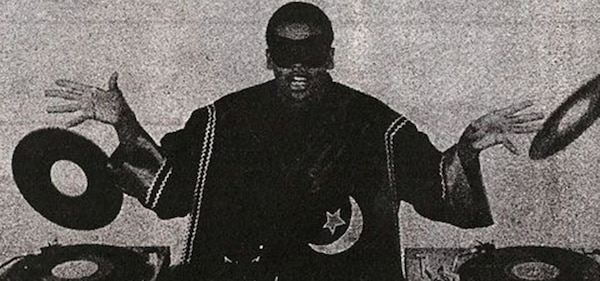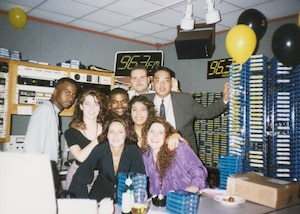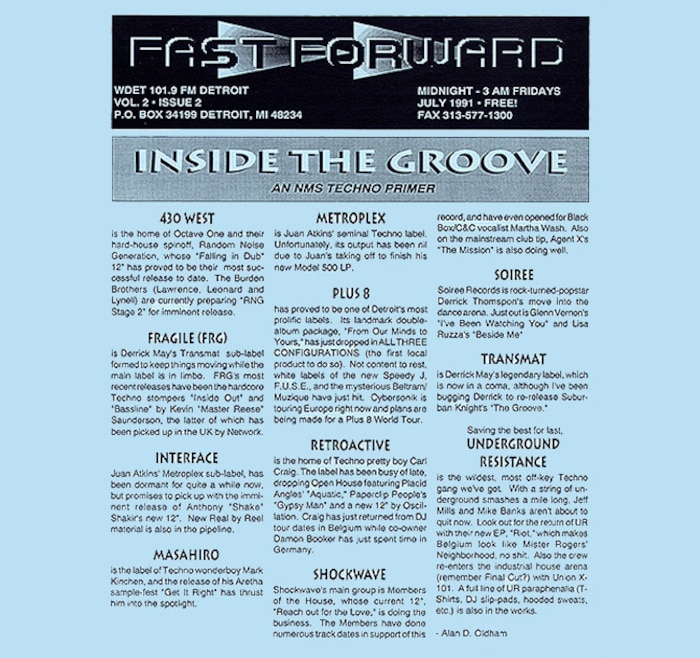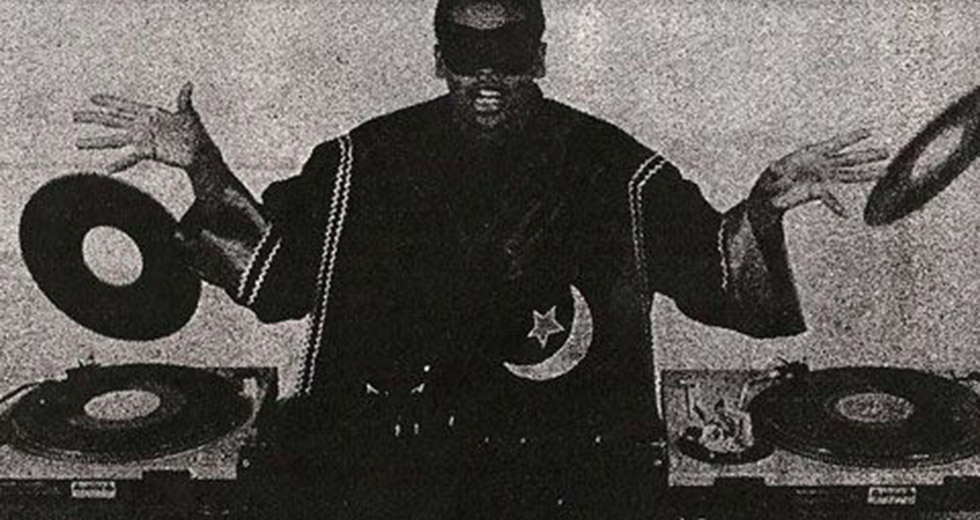A Spin on Frequency: A History of Dance Music Radio in Detroit

It can be a common misconception that since Detroit is the birthplace of techno, there is a huge presence for the genre on radio. But this notion strays far from reality, as the highpoints in Detroit’s dance music radio have been few and scattered over the course of the last 40 years – an odd twist considering Detroit’s massive impact in that region of music.
That said, Detroit’s select dance radio personalities and DJs over the years have had unique passion and vision, and their impact on the city’s disco, house, techno and soul scenes has been enormous. There was, of course, the reign of The Electrifying Mojo, who was followed by his successor of sorts Lisa “Lisa Lisa” Orlando. There was also the impact of Billy T, who was important to Detroit’s soulful house sound, and Alan Oldham’s late-night Fast Forward show, which brought numerous Detroit techno artists to the forefront. There was even a brief flurry of pirate radio, one of which was run by Juan Atkins, Kevin Saunderson and Derrick May.
Most dance music histories of Detroit radio, though, begin in the mid-’70s. About 45 minutes west of Detroit in the nearby city of Ann Arbor, a young man named Charles Johnson was getting his foot in the door at a University of Michigan radio station during the disco boom. He was developing his future persona, one that would soon break Prince, Kraftwerk and The B-52’s into the Detroit market just a few years later. By 1977, he was The Electrifying Mojo on Detroit’s WGPR.
“Mojo was the Michael Jackson of radio here in Detroit,” says Bruce Bailey, a house music DJ from Detroit who played on WJLB. “He had a personality and a swag about his show where he could do whatever he wanted to do. He was on after dark. He was a personality, but he was able to drop music that other stations couldn’t. He inspired every DJ from that era and I definitely had a personal connection to him. He was a rebel. He would do nights of all Prince, and then nights of all Michael Jackson – for three hours. I think he [might have] initiated the battle of two artists every other song. I don’t remember him having many guests… it was about him and the music. He would talk – not too much, but just enough to keep your attention.”
WGPR was primarily geared toward the black community with formatting that included urban contemporary, R&B, soul, gospel and various ethnic programs, but Mojo was doing his own thing – he didn’t adhere to any select format, a trademark of his persona that continued throughout his radio career. Mojo was known for mixing absolutely anything out of the station’s little studio on East Jefferson Avenue and making it work. As a result, his fan base was racially mixed, defying the usual separation of stations back in that era. He was also known for playing music virtually unknown at the time, music that would often get popular a few months (or years) later. “Mojo’s early days on WGPR were the most influential to me,” says Oldham. “He would play Funkadelic, Kraftwerk, Alice Cooper, The Isley Brothers, and Peter Frampton all in one set. On a black station.”
And that was Mojo’s calling – his music selection transcended race, plus he was equally obsessed with the futuristic, starting each show with an introduction that mimicked a “mothership” landing. This latter interest dovetailed perfectly with the early Detroit techno sound. In 1980, A Number of Names brought a demo of “Sharevari” (often dubbed the first Detroit techno record) to Mojo. Thanks to Mojo’s constant play of the track to his ever growing cult-like following, by the time it dropped in 1981, it was already a dance floor hit. With a knack to foresee future trends, Mojo was pushing a scene and culture that would later be revered worldwide as the Detroit techno movement. “Mojo was playing our music, and he was playing music that inspired us and different artists from around the world,” says Kevin Saunderson.
I took [Mojo’s] concept – the theater of the mind – and... I guess I was pretty successful because we were on the 21st floor, and every Saturday, the security guard down there would say, “You have five kids down here wondering how to get into the club.”
Mojo switched stations to WJLB in 1982. Right before Mojo made the move, WGPR received its highest ratings, often jumping into the Top 10. But by switching to WJLB, Mojo had a platform for landing the mothership, his call to fame along with calling all listeners to join his “Midnight Funk Association.” His nightly landing of the mothership had an outer space feel, making Mojo seem even more mythical and mystical. “We would literally go on the porch and turn the light on,” recalls Orlando, “and it was like, the Mothership is landing! We would be in the car and would flash our lights and honk the horn, or we’d go to the car from the club at midnight. He made you think that this was really happening.”
Now stationed at the top of the Penobscot Building in downtown Detroit’s financial district as opposed to East Detroit, Mojo had a new view of the city to inspire him at WJLB’s studios. The view from a studio is not an unimportant one: At WDRQ and WDVD’s studios in the Fisher Building, one can see Detroit landmarks such as the Ambassador Bridge, which connects Canada to the U.S., and the old Book-Cadillac hotel. It was at these stations that Lisa Lisa, real name Lisa Orlando, built her own reign in Detroit’s dance music radio world. “I took [Mojo’s] concept – the theater of the mind – and I decided I was going to create a nightclub in the penthouse of the Fisher building,” she says. “So we called it the ‘Party in the Penthouse: Saturday Night Live’ and I guess I was pretty successful because we were on the 21st floor, and every Saturday, the security guard down there would say, ‘You have five kids down here wondering how to get into the club.’”

Techno DJ and producer Claude Young would frequently join Orlando in the studio, where she hosted rap battles. “He was in the production room one Saturday night,” recalls Orlando, “and he was banging around, playing with records, mixing and stuff, and I would run in there when I got off the air at 2 AM but he’d be in there all night working. I asked him, ‘Hey Claude, how about doing Saturday Night Live one night, or even just making a tape?’ I still have that first mix, and from that mix I knew this guy would be something. Anyways, I was like, ‘You lay your beats and let’s see if [the rappers] can keep up!’”
Orlando bridged the worlds of hip hop and dance music. She believes Young even laid down the beats for Eminem’s first on-air rap. “I would have a freestyle competition where I had like 24 rappers, these young guys, and I’d keep them in rotation,” says Orlando. “I got LL Cool J to host one and I picked out three or four of the best rappers to rap over the beats Claude had laid down, and LL would jump in every now and then – that’s the show Eminem rapped on.”
Jeff Mills would make these records talk to each other and then when he was done playing the records, he’d throw them. I’m watching this going, “This is freakin’ unbelievable!”
Orlando is frequently remembered for giving then unsigned 15-year-old rapper Eminem his first on-air break, but it’s often forgotten that, years earlier, Orlando discovered Jeff Mills, who was DJing in an East Side nightclub at the time. “I was the promotion director [at WJLB back then], so my job was to go to clubs and find places to hold parties,” says Orlando. “I lived in Grosse Pointe Park, which, at that time, was the DMZ – it was right at the edge of Detroit before Grosse Pointe. Not the greatest neighborhood, but there was a beautiful club over there called Club UBQ and it was on Van Dyke. So I went in there one night thinking this would be a great place to host a WJLB event. I’m sitting in the upper level, looking into the DJ booth … there’s this skinny, little, young kid making records – I swear to you – making records talk to themselves and talk to each other. He’d do Prince’s ‘Controversy,’ and then he’d do Hashim’s ‘It’s Time,’ and then Janet Jackson’s ‘What Have You Done for Me Lately.’ He’d make these records talk to each other and then when he was done playing the records, he’d throw them. I’m watching this going, ‘This is freakin’ unbelievable!’”
She handed Mills her business card. “I finally had enough guts to go over there and ask him how he was doing this, what he was even doing. He was like, ‘this is what I do! I just feel it, I just hear it!’ He had probably four crates of records in this little DJ booth and I have never to this day seen anything like what he did there. People thought it was one big record – that’s how flawless and seamless his mixes were. I told him, ‘Can you make me a cassette? I want you to be on the radio.’”
Orlando met Mills at his brownstone on Jefferson a few weeks later and he handed her a tape. She brought it to her colleagues, who were blown away at the fact that the music was a live mix. Thus began the era of “The Wizard.” Mills began mixing hip hop, electro funk, house, techno, and anything else that struck his fancy, working at both WDRQ and WJLB.
The few intertwining years when Orlando, Mojo and Mills were on-air was the golden age for dance music in Detroit major market radio. The trio helped create a soundtrack that reached into the past, but also pushed the developing sound of the city. “One of my best experiences when I was doing this mix show [was with Kevin Saunderson],” remembers Orlando. “I think it was ‘Big Fun’ or ‘Good Life,’ I can’t remember which one he released first… the vocalist on it was a lady named Paris Grey. Kevin was one of my mixers on a Saturday night and he comes walking in with Paris Grey. I was like, ‘Oh my god! This is really cool!’ We put the instrumental track he had on a big reel-to-reel, and I was like, ‘No one is going to believe this ten years from now.’ I knew it was going to be big.”
Orlando was the queen of Detroit’s major market dance music radio for nearly 30 years. For a brief period during her run, Alan Oldham was pushing the underground in a different realm: college radio. In 1987, Oldham, a student at Detroit’s Wayne State University, received his first radio show at WDET after an internship the summer prior. It was called Fast Forward. “[My boss Judy] Adams chose the name ‘Fast Forward,’” says Oldham. “I got all the insomniacs, night owls, artists and freaks, and later, club kids. I started on Friday night/Saturday morning 3-6 AM, then later got moved up to 12-3 AM. ‘Fast Forward’ ran from 1987 to 1992.”
I kicked Derrick May out of the studio with the mic open, live on air. I didn’t speak to him for a year after that, I think.
Oldham would often play music so unusual or futuristic (at the time) that listeners would call in to the station begging to know more about what they were hearing. “I remember this hippie-sounding guy called in one night as I was playing Phuture ‘Acid Tracks,’” he recalls. “The whole side of the record, 15 minutes of acid. He was freaking out. He loved it.” He also introduced listeners to music outside of what they were used to. “I got the black audience into Front 242 and Skinny Puppy,” says Oldham. “I broke Moby on Detroit airwaves, I discovered the black industrial band Code Industry, and made a local hit out of Negativland’s ‘Escape from Noise.’ One time, I was playing the KLF ‘What Time Is Love,’ which sampled the MC5’s ‘Kick Out the Jams’ The red line started blinking, that was the boss’ line. I thought I was in trouble! But it was [my boss] Judy – she loved it and wanted to know who made a dance music track out of the MC5!”
Oldham’s DJ friends in the techno community would frequently join him in the studio or give him music to play. “People used to give me a lot of white labels and tapes to play on air. There was [even] a time when Derrick May took a record that was playing off the turntable, and I kicked him out of the studio with the mic open, live on air. I didn’t speak to him for a year after that, I think.”

With the techno movement on the rise, Oldham helped push the emerging sound. “Alan Oldham really supported us,” says Saunderson. Oldham was instrumental in building the foundation of Detroit techno, even though it seemed like just fun at the time. “For my part, I was just opening up and sharing my crazy musical tastes with people,” he says. “And it just so happened that it was concurrent with the rise of Detroit techno, Chicago house, Belgian New Beat, England’s ‘Summer of Love,’ the coming of ‘raves’ to Detroit, and many other movements and forms.”
After Oldham’s run, in the early-to-mid ‘90s Detroit saw its share of pirate radio, similar to what was happening overseas in London. The UK phenomenon inspired Juan Atkins, Kevin Saunderson and Derrick May to try to institute something similar in Detroit. “In ‘88, ‘89, ‘90, ‘91… in all those years especially, ‘88 and ‘89 were THE pirate radio years [in England],” Saunderson remembers. “We experienced pirate radio [in the UK]. We did some interviews, went to some of their shows in the most pirate locations. It was huge.
“In the UK, there were several [pirate radio stations] and they were playing all of our music along with all of the early house music,” he continues. “They were making an impact and we were trying to duplicate it. They had people listening; they were cultivating a scene of people with new music from Detroit and Chicago, and people were ecstatic over it….I didn’t really understand what pirate radio was all about when I first went over there [to the UK]. It was just radio to me, but it was cool to hear my track on the radio. It was very underground… nothing real glamorous about it. It was all about getting the signal out and getting it to the people.”
There was one [broadcast] on a friend’s boat on the Detroit River. There’s a reason why, too… it was harder to track [pirate radio on the water]. That’s what we were told, at least.
Although it was very short-lived, the Belleville Three created a similar sensation in Detroit. “We didn’t think we had a shot on regular radio [to play our music at the time],” says Saunderson. “We didn’t have the right places to be heard. We did some mix shows, stuff like that, but had more control over what could be played on our own station. We didn’t necessarily have to mix it or master it [with pirate radio] – you could just play a record.” According to Saunderson, Atkins had equipment to broadcast with, and the two – along with May – would transmit from several secret locations throughout the city. “There was one [broadcast] on a friend’s boat on the Detroit River,” says Saunderson with a laugh. “There’s a reason why, too… it was harder to track [pirate radio on the water]. That’s what we were told, at least.”
Pirate radio was a federal offense, and getting caught meant facing jail time. Luckily, the Belleville Three were never found out – which may largely be due to the fact that they were too afraid of the consequences to do more than just a few broadcasts. Eventually, though, the trio got their own mainstream radio slot. “We started doing stuff on WGPR,” says Saunderson. “We weren’t really playing, but they had this open air where you could buy radio time, and it was more like you could be a sponsor of the show. And if you’re a sponsor, you can basically control the music, so that’s when we started doing Deep Space. It lasted maybe about eight months.”
Deep Space on the radio was all about the future of music, with one-to-two-hour episodes that were broadcast once a week. “It was about the introduction of new artists and their music,” Saunderson explains. “It was spoken word, a lot of effects, atmosphere. I had an intro that lasted about three minutes and sounds going, ‘Deep Spaaaace’… all that kind of stuff. We had this DJ called DJ Minx and she was also a voice that introduced the show. Sometimes it was me, sometimes it was Juan, sometimes it was Derrick, and sometimes it was Eddie Fowlkes.”
Deep Space was just one of many important moments in the history of WGPR (along with Mojo’s run), a station that proved to be vital to Detroit’s dance music development. (Its TV counterpart also hosted important dance shows like The Scene and Contempo.) Billy T was another key player from WGPR. Just like Orlando, Billy T (real name William Thompson) bridged dance with hip hop – however, his music selection was more soulful. He would bring local rap talent to his show Basement Tapes, but he’d also invite people like Terrence Parker on board for mixes from 1988-1992. “I used to call him Mr. Terrence Parker back then,” says Thompson. “Him, Juan Atkins, Eddie ‘Flashin’’ Fowlkes, Derrick May… They used to do mixes for my show when I first started out in radio.”
Thompson’s commitment to soulful house would be taken up by Theresa Hill years later. In the early 2000s, Hill had a show called After Work House Grooves on WDTR, where house DJs such as DJ Cent would spin every Thursday from 5 to 6 PM. “She had drive time house for maybe an hour,” says Bailey. “They did pre-mixed CDs and they’d come out and talk about music and the scene. She had Terrence Parker, Delano Smith, Norm Talley as guests… anybody in Detroit who was DJing, she had at least an hour on her show dedicated to that person.”
Hill also hosted Club Insomnia on WJLB, which Bailey used to listen to often. He also recalls listening to house mixes from Kim “The Spin Doctor” James, plus Duane “In the Mix” Bradley, who had a lunchtime mix at noon until his passing in 1999. Bradley is remembered as one of the most important figures in Detroit radio during his 20-year span at WJLB. “People looked forward to [his lunchtime mix],” says Bailey. “He’d break out some classics and fan favorites. ‘You Used to Hold Me,’ Lonnie Gordon, Xavier Gold, a lot of Chicago sound.”
However, by 2005 – April 1, 2005, to be exact – dance music was virtually extinct in Detroit major market radio. That was the day WDRQ switched formats to Variety Hits. I personally recall getting in the car, flipping on WDRQ and hearing classic rock. It seemed to be a bad April Fool’s Day joke – but the next day, the new format continued. “I remember walking in to my show and standing there with my air mates,” recalls Orlando. “We were told, ‘This station isn’t going to be on air anymore. It’s going to be automated.’ We were handed severance packages. At that moment, I thought it was pretty much a wrap. I didn’t think [my career in radio] would happen anymore.”
Now you’ve got guys in suits and ties in Texas deciding what to play on their five stations in Detroit.
And it didn’t, until 106.7 (WDTW) relaunched as “The Beat of Detroit” in 2009, a station that followed WDRQ’s prior format closely with a mix of dance, disco, and rhythmic adult contemporary. It was only natural for Orlando to be brought back onboard, but the station was short-lived. By 2011, it transformed into 106.7 “The D” – a classic rock format. Since then, Orlando has focused on her law firm, where she practices as an entertainment lawyer. She doesn’t see any outlet for a disco/dance lover like herself in the current Detroit radio industry. “It’s a shame, really,” she says. “I think when the FCC deregulated media, big corporations came in and scooped up stations. Now you’ve got guys in suits and ties in Texas deciding what to play on their five stations in Detroit. I guess dance music wasn’t popular enough. It ended up being a specialty show and that ended up being run by clients. It wasn’t about the music – it was about this client is spending $40,000 a year, so do whatever that client says.”
Bailey has a similar theory. “People who have the keys make the rules,” he says. “I guess the programmers didn’t – and still don’t think – house music is as prevalent as it really is globally. I think their eyes are set on R&B, hip hop… that’s what 99% of the stations play during drive time outside of talk radio here in Detroit.”
Nowadays, stumbling across a non-top 40 techno or house mix on air is a rare find – like searching for a needle in a haystack. “Radio is now the opposite of what dance music was or hip hop was in Detroit,” says Orlando. “It was such a grassroots [movement]… people loved what they were creating; they got emotional about what they were creating. Whether you were a rapper or a house DJ or a techno DJ, you were doing this not necessarily for the paycheck, but for the love of the craft… and I think that showed in what they produced. To create something with emotion, you can’t be censored. Detroit is emotion-driven, [and radio is censored].”

